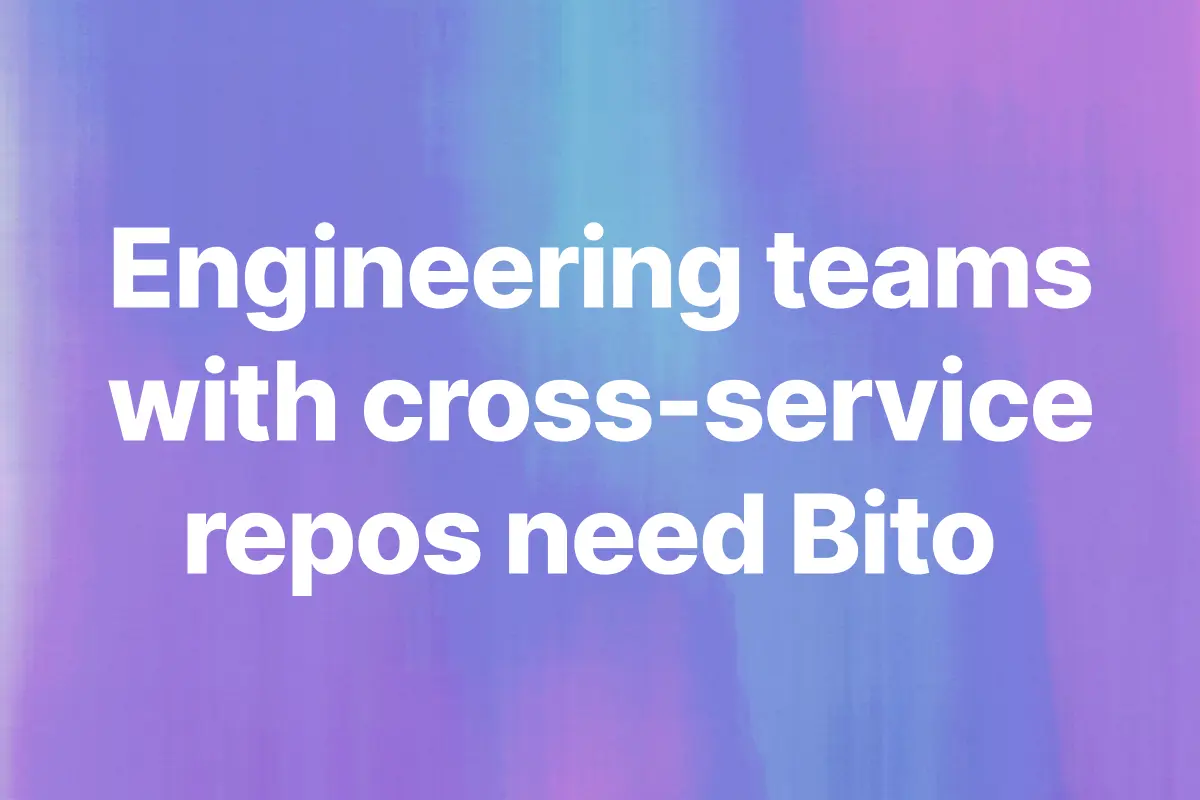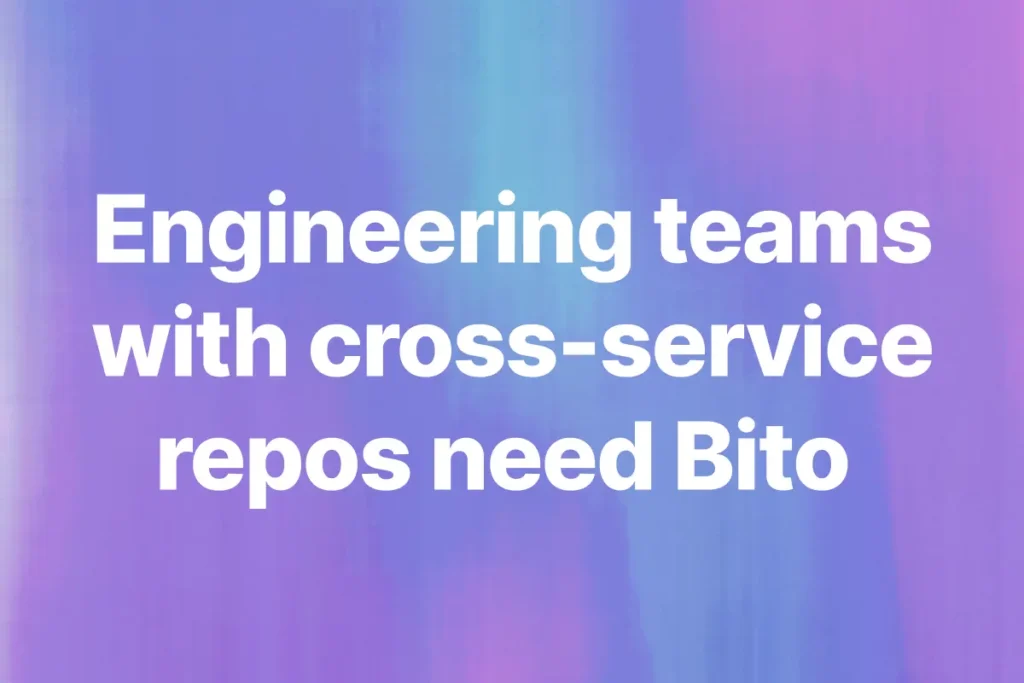Code review does not scale the way your architecture does.
In teams managing 15 or more services and dozens of active repos, a single PR can span APIs, shared libraries, and system contracts. Reviewers spend time jumping between repos, retracing schema changes, and guessing at downstream impact.
These slowdowns add up:
- 4.2 days: Average time a pull request waits before first review (LinearB)
- 48–60% longer: Review time for cross-repo changes vs single-repo (GitHub Study)
- 66% of devs: Say unfamiliar code is their top review bottleneck
- 30% drop: In team throughput tied to slow or inconsistent reviews
Teams turn to Bito when these symptoms start compounding. It helps review faster, catch more issues, and unblock engineers without adding meetings or overhead.
What changes when teams add Bito to cross-service reviews
As services grow and codebases spread across repos, code reviews slow down or fall apart. Bito brings consistency, speed, and context back into that loop. A few examples:
Privado: Faster, more predictable reviews across services
Privado is a developer-first data privacy platform that helps companies monitor how personal data is handled across their codebase. Their team was scaling fast, working across multiple active codebases. Reviews were either delayed or rushed, and test coverage slipped under pressure.
Bito stepped in to automate early review, flag missing coverage, and clean up repeated logic.
What changed after Bito:
- 2+ hours saved per developer, per day
- 30% improvement in overall engineering productivity
- Review consistency improved across teams
- Developers felt more confident shipping code across the stack
- 82% of developers reported higher satisfaction
OBDS: Safer code changes, fewer bottlenecks
OBDS builds aviation-critical software. With over a million lines of code, reviews were slow, uneven, and prone to misses.
Bito integrated with GitHub to flag issues, summarize changes, and help catch bugs in old code before QA.
“It would have been a programmer looking through all of that code for hours… but Bito caught the logic errors and prevented unhandled exceptions saving us valuable time.”
What changed after Bito:
- 130,000+ lines reviewed in a single sprint
- 473 issues flagged, including in dormant parts of the codebase
- 24 hours saved every sprint cycle
- Fewer bottlenecks for senior reviewers
How Bito fits into multi-repo review workflows
In complex systems, a single pull request can span multiple services. Reviewers lose time chasing context across repos. Feedback slows down.
Bito fits directly into this workflow. It integrates directly into your Git and IDE, and delivers fast, context-rich feedback without requiring new dashboards or tools.
Key aspects that support multi-repo workflows:
Codebase-aware reviews
Bito builds a multi-repo map of your system. It analyzes imports, module structure, build files, CI pipelines, and service communication to understand how services connect. This context is pulled into every review automatically.
“Bito gives targeted, context-aware feedback that reduces the load on reviewers and improves overall quality. It’s a valuable part of our daily development workflow.”
Review guidelines that scale across teams
Bito enforces your org’s engineering practices in every review. Teams can define and scale review rules in three ways:
- Project guideline files in-repo: Add .cursor/rules/*.mdc, .windsurf/rules/*.md, or CLAUDE.md files to your repository. Bito automatically applies these rules during code review. Each comment links to the specific rule that triggered the feedback.
- Custom rules in Bito Cloud: Use the dashboard to define organization-wide rules for style, structure, security, or architecture. Apply different rule sets to different services. Manage them without editing the repo.
- Inline learning from feedback: When developers downvote suggestions in a pull request, Bito suppresses similar feedback in future reviews and generates rules automatically.
These options help large teams maintain consistency without adding new layers of process.
AI Architect: Multi-repo context engine
Bito’s AI Architect powers every review by generating system-level context ahead of time. It pulls from source code, build systems, runtime telemetry, service definitions, and IaC configs to construct a live model of your architecture.
This context is refreshed continuously and used to:
- Detect cross-repo dependencies
- Map critical data flows and service boundaries
- Flag API, schema, and infra changes that impact system behavior
AI Architect gives Bito the context to flag impact that single-repo tools miss. Reviewers see what changed and what it affects, before the code merges.
Example PR: https://gitlab.com/bitoco/agent-exec-mgmt/-/merge_requests/511
Flexible placement in the workflow
Some teams run Bito in IDE to catch quick issues before push. Others run Bito post-PR inside Git. Bito works in both setups.
Outcomes these features enable:
- Consistent review quality across unfamiliar code
- Early feedback without adding load on senior engineers
- Fewer manual checks for test coverage and logic issues
- Less review drift across repos and teams
In a recent study, LinearB inspected ~1,000,000 PRs and found that pull requests wait on average 4+ days before being picked up. Graphite found that very large PRs (500+ lines) can take around 9 days to merge, vs small ones (under 100 lines) which can go in within hours.
Bito reduces this delay. It delivers review feedback faster, with system-level awareness and built-in standards.
Why engineering teams choose Bito
When pull requests span multiple services and repos, review speed and consistency suffer. Bito helps teams stay fast without cutting corners.
It brings context into every review. It applies team-defined standards automatically. It flags real issues in code, schemas, and shared contracts before a human steps in.
“Code quality is what makes or breaks your business when it is designed for reliability and Bito delivers on that value.”
Teams with complex systems choose Bito to reduce merge delays, unblock developers, and ship with confidence across all their code.
Try Bito on your next cross-service PR. See what changes.






